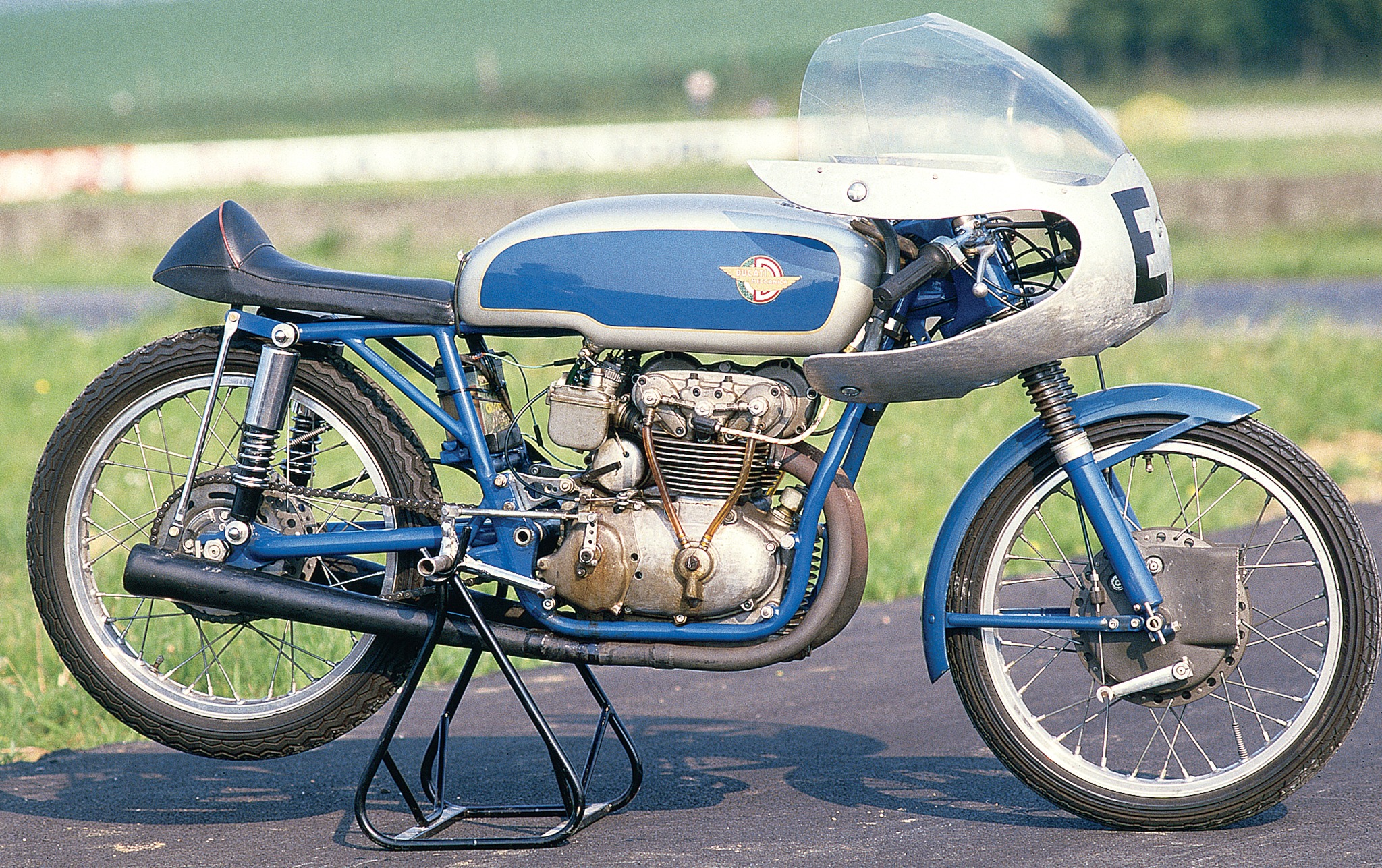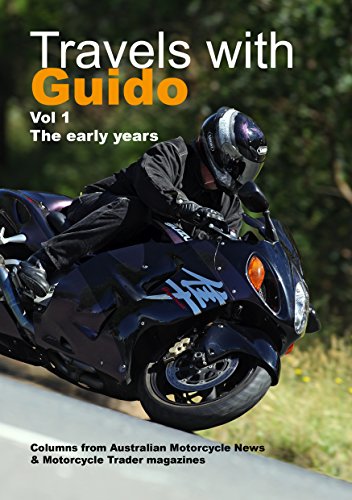Motorcycle Investor mag
Subscribe to our free email news
Ducati 125 Desmo
(by Ian Falloon, Oct 2022)

Pioneering
two-pot screamer
The
first indication that Ducati were interested in building
larger, multi-cylindered motorcycles came at the Milan
Show in December 1956, with the unveiling of a 175cc
double overhead camshaft parallel twin with exposed
valve springs.
This
was raced in the final, 1957, Giro d’Italia by Leopoldo
Tartarini, but it retired in the 3rd stage. Dating from
drawings first sketched by Taglioni in 1950, it was an
interesting, if complicated design, with the pressed up
crankshaft consisting of two flywheel assemblies clamped
by Hirth (radially serrated) couplings.
A
jackshaft was driven off the middle of the crankshaft
and this drove the twin overhead camshafts by a train of
spur gears. While the 49 x 46.6mm 175 produced
considerably more power than the 175cc single cylinder
Gran Sport at 22 bhp at 11,000rpm, the narrower power
band and increase in weight to 112kg (247 lb) largely
negated this benefit.
The
175 became the basis for a 125cc Grand Prix machine
first raced by Franco Villa at the Italian Grand Prix at
Monza in 1958 where it finished third in that remarkable
Ducati 1-5 clean sweep.
This
125 was intended to replace the single by producing more
horsepower through increased revs, and the 42.5 x 45mm
engine produced 22.5 bhp at 13,800rpm. A similar three
camshaft desmodromic valve system to the single allowed
the engine to rev to an amazing (for the time) 17,000
rpm, but the power band was extremely narrow and the
bike difficult to ride despite having a six-speed
gearbox.
As with the 175 twin, the 125 was also too heavy at a claimed 92kg (203 lb), and the handling was less than satisfactory. Compared with the single, the twin (of which only three were built) didn’t achieve much success. Breakages in the camshaft drive gear train often occurred, with disastrous results, and the bikes were sold at the end of the 1959 season, two of which ended up being raced by Mike Hailwood.
It was during 1959 that Stan Hailwood commissioned a
250cc version for Mike to race in 1960. Revealed to the
press in February 1960, the 250 shared the same 55.25 x
52mm dimensions with the 125cc single, but in other
respects was a scaled up 125 twin. The power was 43bhp
at 11,600rpm, and it was a very fast motorcycle with a
top speed in the region of 218 km/h (135 mph), but it
handled poorly and was considerably overweight.
At about the same time, Ken Kavanagh, about to undertake
his successful series in Australia, persuaded the
factory to build a 350cc desmo twin for the 1960 season.
This appeared in time for Kavanagh to race at Imola in
April but an accident prevented him from riding it until
the Isle of Man, by which time Hailwood also had a
similar machine.
With
a bore and stroke of 64 x 54mm, the 350 produced 48bhp,
but the engines vibrated badly and the bikes needed a
lot of development to be competitive. At the end of the
season John Surtees bought both Hailwood’s 250 and 350,
followed a few months later by Kavanagh’s.
They received new frames and leading-link forks by Ken
Sprayson and Phil Read rode a 350 at the Isle of Man in
1962 where it blew up in practice. They were raced
unsuccessfully for a couple more domestic British
seasons.
There was however to be one more multi-cylindered
disaster. Seeing the limitations of a single, or even
twin, at Grand Prix level, Taglioni designed a 125cc
in-line four cylinder engine in 1958. This idea was
advanced for the time but with Ducati’s withdrawal from
competition at the end of 1959, the design languished
until the Spanish Mototrans concern persuaded Ducati to
produce it five years later, in 1964, by which time it
was obsolete in a few design areas.
There were four non-desmo valves per cylinder and a very
wide 90 degree included valve angle. The double overhead
camshaft 125 used a train of gears on the left side of
the engine to drive the camshafts. With a compression
ratio of 12:1 and four 12mm Dell’Orto carburettors, the
34.5 x 34mm engine produced 23bhp at 14,000 rpm, hardly
outstanding considering that the 125cc twin had produced
22.5bhp in 1958.
Even with twelve months of development the power was
only increased to 24 bhp at 16,000 rpm, and Ducati
realised that it would never be competitive at Grand
Prix level. Only two bikes were built and during 1966
the 125 four quietly disappeared.
The
entire parallel twin and four cylinder episode was
interesting in that they were the first Ducatis designed
exclusively for racing bearing no relationship to any
road bikes.
Because they were so unsuccessful compared to the Gran
Sport derivatives none of their features ended up on the
production line, but they certainly had the effect of
creating a Taglioni philosophy that would prevail in the
future. That of producing a motorcycle with a balance of
power and weight.
There was no point in an unnecessarily complex and heavy
motorcycle if this did not translate into improved lap
times. Also, what good was a powerful motorcycle if it
did not handle well or the powerband so narrow that it
was unride-able?
Not only was it significant that the desmodromic Grand
Prix racer was closely derived from a road bike (albeit
a catalogued racer with lights), but all future Ducati
success would emphasise a broad range, rather than
outright power, and a balance between
power and weight
-------------------------------------------------
Produced by AllMoto abn 61 400 694 722
Privacy: we do not collect cookies or any other data.

Archives
Contact





